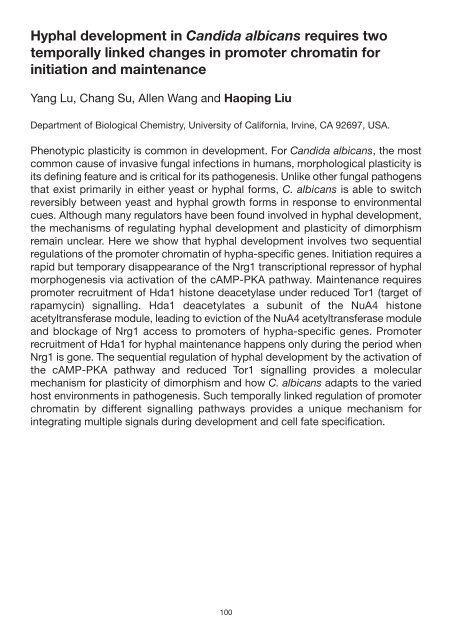Candida Infection Biology – fungal armoury, battlefields ... - FINSysB
Candida Infection Biology – fungal armoury, battlefields ... - FINSysB
Candida Infection Biology – fungal armoury, battlefields ... - FINSysB
Create successful ePaper yourself
Turn your PDF publications into a flip-book with our unique Google optimized e-Paper software.
Hyphal development in <strong>Candida</strong> albicans requires two<br />
temporally linked changes in promoter chromatin for<br />
initiation and maintenance<br />
Yang Lu, Chang Su, Allen Wang and Haoping Liu<br />
Department of Biological Chemistry, University of California, Irvine, CA 92697, USA.<br />
Phenotypic plasticity is common in development. For <strong>Candida</strong> albicans, the most<br />
common cause of invasive <strong>fungal</strong> infections in humans, morphological plasticity is<br />
its defining feature and is critical for its pathogenesis. Unlike other <strong>fungal</strong> pathogens<br />
that exist primarily in either yeast or hyphal forms, C. albicans is able to switch<br />
reversibly between yeast and hyphal growth forms in response to environmental<br />
cues. Although many regulators have been found involved in hyphal development,<br />
the mechanisms of regulating hyphal development and plasticity of dimorphism<br />
remain unclear. Here we show that hyphal development involves two sequential<br />
regulations of the promoter chromatin of hypha-specific genes. Initiation requires a<br />
rapid but temporary disappearance of the Nrg1 transcriptional repressor of hyphal<br />
morphogenesis via activation of the cAMP-PKA pathway. Maintenance requires<br />
promoter recruitment of Hda1 histone deacetylase under reduced Tor1 (target of<br />
rapamycin) signalling. Hda1 deacetylates a subunit of the NuA4 histone<br />
acetyltransferase module, leading to eviction of the NuA4 acetyltransferase module<br />
and blockage of Nrg1 access to promoters of hypha-specific genes. Promoter<br />
recruitment of Hda1 for hyphal maintenance happens only during the period when<br />
Nrg1 is gone. The sequential regulation of hyphal development by the activation of<br />
the cAMP-PKA pathway and reduced Tor1 signalling provides a molecular<br />
mechanism for plasticity of dimorphism and how C. albicans adapts to the varied<br />
host environments in pathogenesis. Such temporally linked regulation of promoter<br />
chromatin by different signalling pathways provides a unique mechanism for<br />
integrating multiple signals during development and cell fate specification.<br />
100


